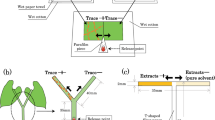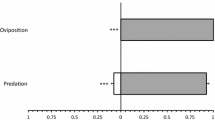Abstract
Predaceous arthropods are frequently more abundant on plants with leaves that are pubescent or bear domatia than on plants with glabrous leaves. We explored the hypothesis that for some predatory mites this is because pubescence affords protection from intraguild predation. In laboratory experiments, we tested whether apple leaf pubescence protected Typhlodromus pyri eggs from predation by western flower thrips, Frankliniella occidentalis. To investigate the effect of pubescence further, we added cotton fibers to trichome-free leaves. We also determined whether webbing produced by Tetranychus urticae protected Phytoseiulus persimilis eggs from predation by F. occidentalis. Predation by thrips on T. pyri eggs oviposited on field-collected pubescent "Erwin Bauer" apple leaves was significantly less than on glabrous "Crittenden" apple leaves. Phytoseiid eggs oviposited in the cotton fibers were preyed upon significantly less than those on the trichome-free bean disk. Increasing the cotton fiber density from 5 to 20 fibers only slightly further reduced predation by thrips on T. pyri eggs. Thrips fed upon significantly fewer P. persimilis eggs oviposited in Te. urticae webbing than eggs oviposited on a surface that differed only in the absence of Te. urticae web. We conclude that a complex leaf topography reduces intensity of intraguild predation in this system.
Similar content being viewed by others
Author information
Authors and Affiliations
Additional information
Electronic Publication
Rights and permissions
About this article
Cite this article
Roda, A., Nyrop, J., Dicke, M. et al. Trichomes and spider-mite webbing protect predatory mite eggs from intraguild predation. Oecologia 125, 428–435 (2000). https://doi.org/10.1007/s004420000462
Received:
Accepted:
Published:
Issue Date:
DOI: https://doi.org/10.1007/s004420000462




